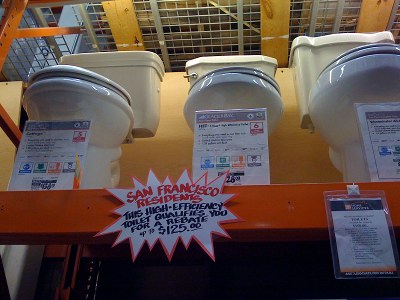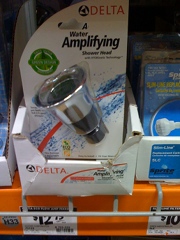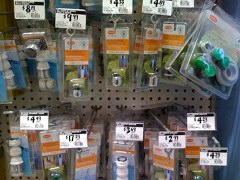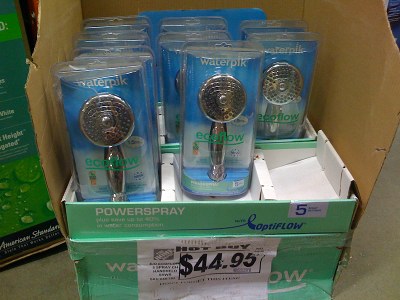
I know the motivation might not be there to take shorter showers when you see your neighbors watering their lawns in the middle of the day or local restaurants hosing down the sidewalks, but cutting back on your water use (or at least feeling less guilty about those long showers) can be as simple as swapping out your old shower head for a lower-flow model, screwing some aerators onto your faucets, and, for the sufficiently motivated, talking to your landlord about installing higher-efficiency toilets.
For me, the first and last stop was calling my utility company, San Francisco Public Utilities. They sent out a water expert armed with free devices for my flat, and in less than an hour we’d outfitted the kitchen and bathroom to be much more water efficient. Save our H2O, a website sponsored by the California Department of Water Resources, has tons of conservation resources including a rebate finder and a list of the state’s local water agencies.
But since I know not every utility offers free devices to customers, last night I dropped by The Home Depot in Daly City, to see what’s available. I have been inside one of these orange megabox retailers exactly three times in my life and it’s always a bit of sensory overload. There must have been close to 100 shower heads to choose from, but it wasn’t easy finding one with a low-flow (1.5 gallons per minute) rating. No matter the price or the size, every model I picked up was either 2.5 gpm, or I couldn’t find the flow rate on the packaging.


I finally asked a salesman who at first couldn’t find one either. But eventually, he found one tucked in among the others: the Delta Water Amplifying Shower Head, for $12.75. It’s actually 1.6 gpm, and it looked kind of small and cheap, although it may work fine. I felt a little disappointed that this was my only option.
Hoping for better luck, I wandered over to the aerator section one aisle over. There I found aerator aficionado heaven. Once again, the selection was a little overwhelming. There were probably 40 aerators to choose from–aerators, no less. Low-flow, 1.5-gpm models like the kind the SFPU gave me ranged in price from $2.99 to $17.39 for the upscale brushed-nickel variety.
Across from the aerators were the toilets. I scanned the high shelf and saw several low-flow models (1.6 and 1.28 gallons per flush) that were priced between $90 and $128. Taped to the toilet shelf was a sign reading that San Francisco residents may be eligible for a $125 rebate on a low-flow model, which could basically mean a free toilet. Other cities and counties in California have similar rebates.
As I turned to leave the toilet/aerator aisle, I bumped into a large box sitting on the floor. There, far from all the others, was the shower head I’d been looking for: a 1.5 gallon-per-minute WaterPik EcoFlow with five different pressures, including something called “Powerspray.” Touting a 40% water savings, these puppies were on sale for $44.95.

Rick Soerhen, the Deputy Director of Water Use Efficiency for the California Department of Water Resources told me that people living in apartments most likely already get “gold stars” for water conservation because they probably aren’t watering lawns and gardens.
So, flat-dwellers, be proud. But if you really want to be as water efficient as possible, devices like these can make a big difference on your total usage — without requiring three-minute showers.
15 thoughts on “Navigating the Urban Water Jungle”
Comments are closed.

Brava to you for reducing your water usage. In addition to the GPM rating of your shower head, look for one that lets you reduce the flow of water to a trickle. That way, you not only reduce water usage while you lather up, you get more time to let the shampoo/conditioner/soap do its work.
The drawback to all these water-saving devices for apt.-dwellers is that we incur all the cost, while the landlord gets all the benefit. How about a follow-up article about persuading landlords to rebate the cost of the devices, if your city or county doesn’t?
I too applaud your efforts to be “smart” about water usage. There are many great products out there, especially water saving toilets – I would recommend checking not only the GPM rating, but also the performance measure as well. Some toilets may be HET (high efficiency), but their ability to flush material is compromised. Home Depot has a good rating scale on their displays for you to compare.
Regarding shower heads, depending on your local Home Depot store, we at American Standard have a 3-n-1 Flowise showerhead which uses only 1.5gpm at around $30. You might find it more to your liking.
G Messina
American Standard
Hi Jake3_14,
Thanks for your comment. I agree that if your goal is financial, buying these new devices and not reaping the cost savings on your bill could be frustrating. However, some landlords might be open to reimbursing tenants for the devices or perhaps even negotiating a rent discount if the water bill actually goes down. They might also be willing to take advantage of some of the rebates offered for low flow toilets. It can’t hurt to ask.
I’ve taken this at least 2 steps beyond…to what I call “Manual Graywater”.
I close the valve on the tub, throw in a few light laundry items such as socks and underwear, start the shower water running onto the clothes while it’s warming up. I then stomp on the clothes while I shower and move them around a bit. I use a very small amt of organic body wash or shampoo.
When my shower is done, I wring the clothes out well into a bucket and hang them on a rack or this neat little device that hangs from the shower head.
Then I scoop the collected water into the bucket to take outside to water the garden. A small amt of soap doesn’t harm the garden. Just be sure and water directly from a hose once in a while where you have used the graywater.
This really keeps my showers short, because every drop has to be hand scooped and carried! The waste is GREATLY reduced and my wastewater processor loves me too!
Easiest way we’ve cut back on water in the bathroom: don’t flush it every time. We started this practice for a different reason: to keep from having the noise of the toilet wake up the baby. That’s not an issue any more, but why send a gallon of water down the drain to remove less than 8 ounces of sterile urine. There is an aesthetic issue, I won’t deny it. It takes some getting used to, and we do flush before company comes over. Also, this probably works better with family than with roommates.
We also use a bucket flush: bucket in the shower while waiting for water to warm up goes directly into toilet (easier than toting out to the backyard).
Thanks for the tips! I also had someone email me asking why I didn’t mention “navy” showers in my radio piece. Certainly, we could all save more water by turning off the tap while we lather up, but that experience sounds way too cold for me. I seriously commend anyone who takes showers like that.
My backyard is right outside my bathroom, so it’s not far to carry…..it is farther than the toilet though.
But then…Why even pee in a toilet? Go outside!
Check out the Humanure Handbook if you really want to understand how to safely save all that clean water that goes down your toilet!
A lot of water is wasted while you wait for hot water. You know, you turn on the shower or the tap, and then wait and wait for it to get hot.
One way to deal with that problem is to get a hot-water recirculating pump. If you’re handy, you can install one in a couple hours, without re-plumbing your house. A company called Metlund makes a good one. http://www.gothotwater.com/
Of course, that’s not really an option for renters. Evolve makes a showerhead called the Roadrunner which automatically shuts off when it gets hot–that way you at least minimize the water wasted while you wait for it to get hot. http://evolveshowerheads.com/
I have my own low-tech strategy for that. While the shower is warming up, I catch the water in a bucket, and later haul it about 12 feet to the upper deck, where I use it to water our tomatoes and greens. Of course, this only works during the growing season but it’s a good semi-solution for condo dwellers.
Being lazy I shunt the shower water, while it is heating up and mixed to my ideal temperature, to a soaker hose in my vegetable garden. The shunt, from Home Depot, is installed prior to the shower head. A hose carries the water out through a partially open window . In San Francisco I would install a through the wall fitting.
My next water saving project is to get a three burner sink. I plan to drain non-soapy water from the third basin to a storage facility and use for our trees.
Another solution would to be to install a garden sink in which to wash items from the garen. The water can be caught in s amall barrel with a outlet hose.
Thanks for this informative article. After hearing this story and talking to some folks, I think we have one if not more leaks in our old 1904 house. And, even though we are renters, we are thinking of getting rid of the cool, yet terrible 5 gallon toilet and replacing it with an efficient one. As a renter, I had no clue that the City of San Francisco would give us a $125 rebate for this. Thanks for a great story.
Low flow toilets are notorious for requiring more than one flush to do the job. Other than that the info is good.
I know this is not a scientific study, but I have three low flow toilets in my apartment, and they all flush fine. Although, Sue Tensfeld (the water use expert in the story) did say that there is a low-flow design, referred to as a “low boy” that can be prone to flushing problems.
Cutting back on beef consumption is a far more effective method of conserving water. Estimates are that 1 lb. of beef requires 2000-5000 gals. of water (beef industry and UC Davis estimates). The water required to produce 1 lb. of beef a month equates to something like 100-250 long, full flow showers. Low flow toilets and shower heads are fine, but insignificant compared to meat consumption reduction.
More than 50% of domestic water is used for landscape watering. The planting of drought tolerant varieties in a xeriscaped yard would save much more water than short showers and low flush toilets.
How about toilets that don’t use potable water for flushing?
Golf courses? Business landscaping? Broken water mains? Dripping faucets? Swimming pools? Car washing? There are a lot of areas that could use conservation methods.